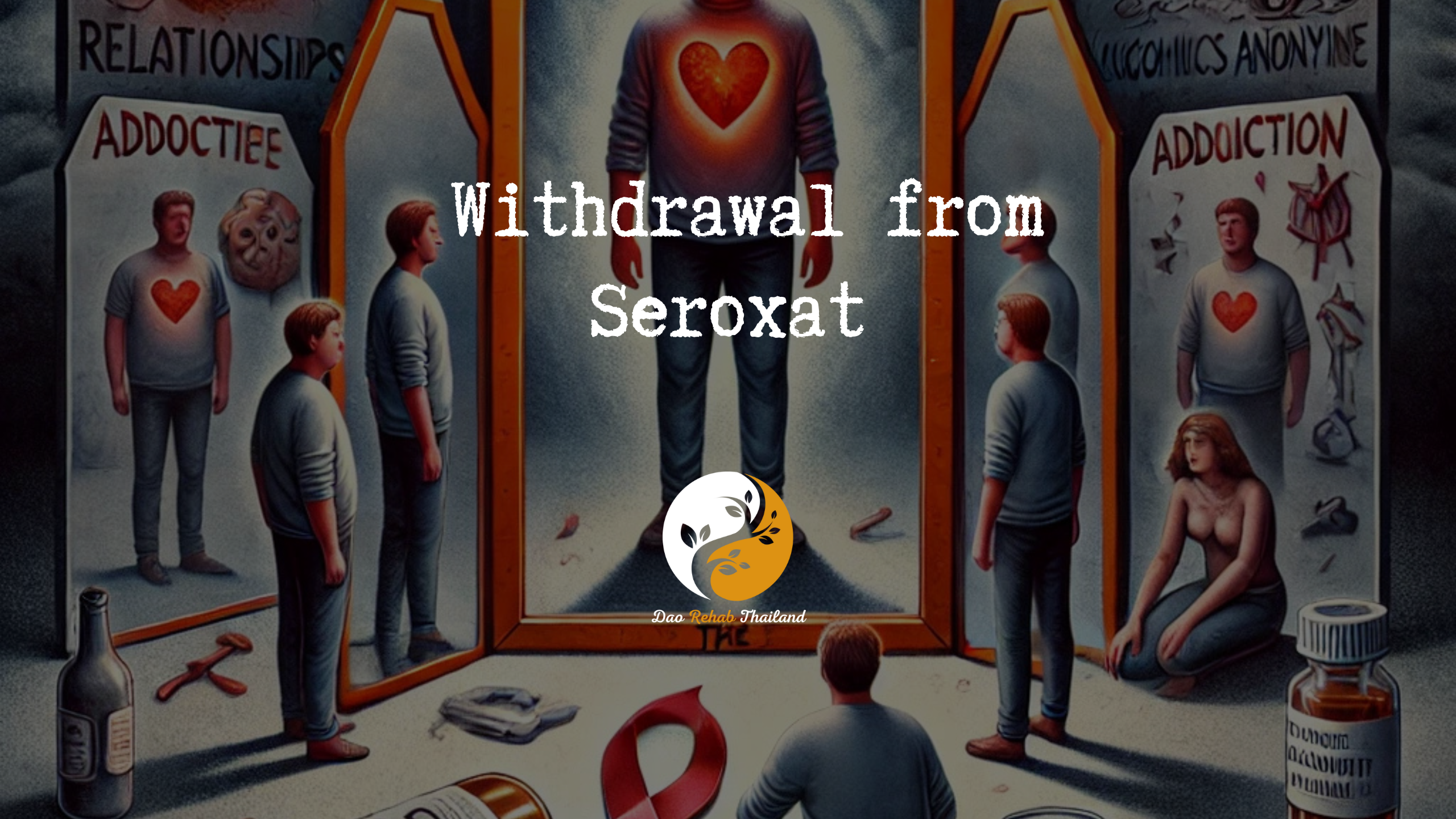
Withdrawal from Seroxat-Holistic rehab in Thailand
Withdrawal from Seroxat
“Turning the impossible into possible”

"Detox from Drugs at a Luxury Holistic Center in Thailand and Israel"

Withdrawal from Seroxat
Seroxat, also known as Paroxetine, is a selective serotonin reuptake inhibitor (SSRI) antidepressant medication. This medication is used to treat a wide range of mental disorders, including depression, anxiety, panic disorder, and obsessive-compulsive disorder (OCD).
"Holistic Center for Trauma, Addiction, and Mental Imbalance Treatment in Thailand"
“Come to the beginning of your journey to freedom from addiction to alcohol, drugs, and pills, and rediscover your life within the serene embrace of DaoTherapy Rehab in Thailand—where holistic healing meets empowering recovery.”
DaoTherapy Holistic Rehab
Key Elements of Drugs Detox:
Medical Supervision: Drugs detox must be conducted under medical supervision, as the body may experience withdrawal symptoms. These can include nausea, anxiety, muscle aches, and insomnia. A medical team will monitor and manage these symptoms to ensure the patient’s safety and comfort.
Holistic Therapies:
Holistic Therapies: Many detox programs incorporate holistic therapies such as mindfulness, yoga, and meditation to help individuals cope with stress and anxiety during the detox process. These therapies support the mind-body connection and contribute to overall recovery.
Tapering Process
Tapering Process: Drugs detox often involves a gradual tapering of the drug to reduce withdrawal severity. Doctors will slowly decrease the dosage over time to allow the body to adjust to lower levels of the substance.
Psychological Support:
Psychological Support: Like any addiction recovery process, detox from Drugs includes psychological support. This can involve counseling, therapy, or support groups to address the mental and emotional aspects of addiction.
Post-Detox Treatment:
Post-Detox Treatment: After completing detox, continuing treatment is crucial to prevent relapse. This often includes participation in ongoing therapy, group support, and the development of new coping strategies to maintain sobriety.
Withdrawal from Seroxat: What you need to know about Seroxat withdrawal, what are the causes of addiction to prescription pills:
The causes of addiction to prescription pills are complex and vary from person to person, and include a combination of genetic, psychological, environmental, biological, and personal factors.
Genetic factors:
Genetic predisposition: Some people are born with a genetic predisposition to addiction. Studies show that there is a genetic inheritance that increases the risk of addiction.
Families with a history of addiction: Those who have parents or first-degree relatives who have struggled with prescription pill addiction may be at a higher risk of addiction.
Withdrawal from Seroxat: Psychological factors:
Mental disorders: People who suffer from depression, anxiety, personality disorders, or post-traumatic stress disorder (PTSD) may turn to drugs to cope with the symptoms of these conditions.
Low self-esteem: A sense of low self-esteem can lead to drug use as a way to escape a painful reality or to improve their sense of self-worth.
Stress and Mental Overload: People who experience chronic stress or increased mental overload may use drugs to relieve stress.
Feelings of inferiority and dysfunction are another psychological factor that can contribute to prescription drug addiction. We will detail this in the context of psychological factors for addiction:

contact us
Contact us with your questions
We would love to speak with you! Feel free to reach out with any questions.

get in touch
Schedule a free consultation
Schedule a free consultation with our team and let’s make things happen!
Historical background and development of the Seroxat
Seroxat, also known as Paroxetine, is a selective serotonin reuptake inhibitor (SSRI) medication. Here is a brief historical overview of the drug:
Development and approval
Initial development
Paroxetine was developed by the British pharmaceutical company Glaxo (now GlaxoSmithKline, GSK) in the 1970s. The drug was developed as part of an effort to identify and design new drugs to treat depression and anxiety, which were becoming increasingly common at the time.
Clinical trials
During the 1980s, paroxetine underwent a series of extensive clinical trials to evaluate its efficacy and safety in the treatment of depression and anxiety disorders. The results of the trials were positive and showed that the drug was effective in relieving symptoms of depression and anxiety with a relatively good safety profile.
FDA approval
In 1992, the drug received FDA approval for use in the United States for the treatment of clinical depression. Over the years, the approval was expanded to include the treatment of various anxiety disorders, such as panic disorder, obsessive-compulsive disorder (OCD), and social anxiety disorder.
Expansion of use
Expansion of labels
After receiving the initial approval, the drug was gradually recognized worldwide for additional uses. Additional studies showed that the drug was effective in treating additional anxiety disorders, and in the following years it received approvals for these uses in many countries.
Market and competition
In parallel with the development and expansion of the use of Seroxat, other drugs from the SSRI family were developed, such as fluoxetine (Prozac), sertraline (Zoloft), and citalopram (Celexa). This competition led to further developments in the field of antidepressant drugs and improved the understanding of mental disorders and their treatment methods.
Regulatory Issues and Controversies
Side Effects and Withdrawal Symptoms
Over the years, side effects and withdrawal symptoms associated with the use of Seroxat have been revealed, causing controversy and debate among experts and health authorities. Some patients have reported severe withdrawal symptoms upon discontinuation of treatment, persistent sexual side effects, and changes in mood and mental health.
Regulation and Monitoring
As a result of the controversies, health authorities around the world have restricted the use of the drug and added detailed warnings to product labels. These developments have highlighted the importance of careful medical monitoring when using antidepressants.
Summary
Seroxat is an important drug in the treatment of various mental disorders, and its history of development and use reflects the evolution of the field of drug treatment for depression and anxiety. While the drug has proven to be effective, it is important to use it with caution and under the supervision of a doctor due to possible side effects and withdrawal symptoms.
About Seroxat
Mechanism of Action
Serooxat works by inhibiting the reuptake of serotonin in the brain. Serotonin is a neurotransmitter that plays an important role in regulating mood, sleep, and emotions. By inhibiting reuptake, Seroxat increases serotonin levels in the brain, which may improve mood and reduce symptoms of depression and anxiety.
Main uses
1. Depression: Treatment of major depression.
2. Generalized anxiety disorder (GAD): Treatment of generalized anxiety.
3. Panic disorder: Treatment of panic attacks.
4. Obsessive-compulsive disorder (OCD): Treatment of intrusive thoughts and compulsive behavior.
5. Social Anxiety Disorder: Treatment of extreme fear of social situations.
Side effects
Like all medicines, Seroxat may cause side effects. Here are some of them:
1. Common effects:
– Nausea
– Dry mouth
– Dizziness
– Increased sweating
– Decreased or increased appetite
2. Less common effects:
– Weight gain
– Sleep disorders (such as insomnia or increased fatigue)
– Decreased sexual function
3. Serious effects (rare):
– Unusual bleeding
– Changes in mood or behavior (such as suicidal thoughts)
– Seizures
Warnings and contraindications
1. Warnings:
– Using Seroxat may worsen your mental state at the beginning of treatment. It is important to be under strict medical supervision.
– Avoid drinking alcohol while using the medication.
– Be careful not to use other medications that affect serotonin at the same time.
2. Contraindications:
– Known sensitivity to paroxetine or one of its ingredients.
– Concomitant use of MAO inhibitors.
Discontinuation of treatment
Discontinuation of treatment with Seroxat should be done gradually and under the supervision of a physician, to prevent withdrawal symptoms such as dizziness, headaches, and irritability.
Consultation with a physician
Before starting treatment with Seroxat, it is important to consult a physician to ensure that the drug is appropriate for your health condition and to ensure that there are no contraindications to its use.
If you have any further questions or if you need more information, do not hesitate to contact us.
What is a Seroxat addiction and how does it develop?
Paroxetine, also known as Seroxat, is an antidepressant medication in the SSRI (selective serotonin reuptake inhibitor) family. Although it is not considered an addictive drug in the traditional sense, it can cause physical dependence and withdrawal symptoms when the drug is stopped abruptly or the dosage is reduced rapidly.
The Addiction Process
Addiction to SSRIs is not as common as addiction to other drugs such as opiates or benzodiazepines. However, prolonged use of Seroxat can cause psychological and physical dependence.
Physical Dependence
Physical dependence develops when the body adapts to the presence of the drug and begins to rely on it to maintain normal function. When the drug is stopped or the dosage is reduced suddenly, the body may respond with withdrawal symptoms.
Psychological Dependence
Psychological dependence develops when a patient feels they need the drug to cope with emotional and mental conditions. This condition can lead to difficulty stopping the drug even when it is no longer medically needed.
Withdrawal Symptoms
Withdrawal symptoms may occur when the use of Seroxat is stopped abruptly or when the dose is reduced too quickly. These symptoms can be varied and include:
1. Physical symptoms:
– Dizziness
– Nausea and vomiting
– Headaches
– Increased fatigue
– Excessive sweating
– Tremors
2. Emotional and mental symptoms:
– Feelings of anxiety
– Increased depression
– Irritability and hypersensitivity
– Feelings of electric shock (“Brain zaps”)
3. Cognitive symptoms:
– Difficulty concentrating and remembering
– Feelings of mental instability
Preventing withdrawal symptoms
To prevent withdrawal symptoms, it is important to discontinue treatment with Seroxat gradually and under the supervision of a doctor or a withdrawal team. This process is called the “withdrawal process” and involves a slow and controlled reduction of the dose over several weeks or months, depending on the patient’s condition and their response to the dose reduction.
Instructions for stopping treatment Use of Seroxat
1. Consultation with a doctor: Always consult a doctor before starting to reduce the dose or stop treatment.
2. Gradual reduction: Reducing the dose in small, continuous steps to give the body time to adapt.
3. Strict medical monitoring: Regular visits to the doctor to monitor the patient’s condition and make adjustments if necessary.
4. Psychological support: It is important to receive appropriate psychological support during the withdrawal period, including psychological therapy or support from support groups.
Summary
Seroxat is a medication for the treatment of depression and anxiety disorders, but stopping its use may cause withdrawal symptoms. It is important to carry out the process of stopping treatment gradually and under the supervision of a doctor or a rehab team to minimize the chance of withdrawal symptoms and maintain the patient’s health.
Withdrawal symptoms from Seroxat
Withdrawal symptoms from Paroxetine (Paroxetine) can be varied and affect both the physical and mental state of the patient. These symptoms usually occur when the drug is stopped suddenly or when the dose is reduced too quickly.
Common Withdrawal Symptoms
Physical Symptoms
1. Dizziness: Feelings of unsteadiness or spinning.
2. Nausea and vomiting: Feeling sick, sometimes accompanied by vomiting.
3. Headaches: Pain of varying intensity in different parts of the head.
4. Fatigue: Feelings of tiredness and lack of energy.
5. Hyperhidrosis: Increased sweating, especially at night.
6. Tremors: Mild or significant shaking of the body.
Mental and Emotional Symptoms
1. Anxiety: Increased levels of anxiety or the appearance of new feelings of anxiety.
2. Increased depression: Recurrent or increased feelings of depression.
3. Irritability and irritability: Increased sensitivity and irritability.
4. Electric shock sensations (“Brain zaps”): Feelings of electric shocks in the head.
Cognitive symptoms
1. Difficulty concentrating and remembering: Problems with concentration and memory.
2. Feelings of mental instability: Feelings of confusion or mental instability.
Mechanism of withdrawal symptoms
Withdrawal symptoms occur following a sudden change in serotonin levels in the brain. Serotonin is a neurotransmitter important for regulating mood, sleep, and emotions. When you stop using Seroxat, serotonin levels can drop rapidly, causing the symptoms to appear.
Prevention of withdrawal symptoms
To prevent withdrawal symptoms, discontinuation of Seroxat should be done gradually and under the supervision of a doctor. This process involves a slow and controlled reduction of the dose over several weeks or months, depending on the patient’s condition.
Guidelines for stopping treatment
1. Consultation with a doctor: A doctor should be consulted before starting to reduce the dose or stop treatment.
2. Gradual reduction: Reducing the dose in small, continuous steps to give the body time to adapt.
3. Strict medical monitoring: Regular visits to the doctor to monitor the patient’s condition and make adjustments if necessary.
4. Psychological support: It is important to receive appropriate psychological support during the withdrawal period, including psychological therapy or support from support groups.
Summary
Symptoms of withdrawal from Seroxat can be varied and affect the patient in many ways. It is important to discontinue treatment gradually and under the supervision of a physician to minimize the chance of withdrawal symptoms and maintain the patient’s health.
Psychological Support:
Psychological Support: Like any addiction recovery process, detox from Subutex includes psychological support. This can involve counseling, therapy, or support groups to address the mental and emotional aspects of addiction.
Prescription drug withdrawal treatments that exist:
Prescription Drug Withdrawal Methods Around the World
1. Medical Detoxification
Controlled Process: Medical detoxification is the first step in the addiction treatment process. During this process, the use of prescription drugs is stopped under medical supervision, while medications are given to relieve withdrawal symptoms.
Symptom Relief: Medications given can include anxiety-relieving, pain-relieving, and seizure-preventing medications.
2. Psychotherapy Treatment Using the Tau Therapy Method
Cognitive-Behavioral Therapy Using the Tau Therapy Method: This treatment focuses on identifying and changing negative thought and behavior patterns related to addiction.
Behavioral Therapy Using the 12-Step Approach: Used primarily to treat addicts with personality disorders, and teaches coping skills and emotional improvement.
Psychodynamic Therapy: Focuses on exploring the emotional connections and early experiences that led to addiction.
3. Group Therapy and Social Support
Support Groups: Groups such as Narcotics Anonymous (NA) and Alcoholics Anonymous (AA) offer support from former addicts through regular meetings.
Family Therapy: Involves the family in therapy to improve family relationships and support.
4. Alternative and Complementary Therapy from Taotherapy
Meditation and Yoga: These methods help reduce stress, anxiety, and improve self-awareness.
Acupuncture: Often used to reduce withdrawal symptoms and drug cravings.
Proper nutrition and exercise**: Improve overall health and help the body recover.
5. Rehabilitation Programs
Inpatient Rehabilitation Centers: Patients are in a treatment center under full supervision, receiving psychological, medical, and
support care.
Outpatient Rehabilitation: Patients continue to live at home but come to the rehab center for treatment and training.
6. Innovative Technologies
Biofeedback: This technology helps patients learn to control physical reactions and reduce stress.
Virtual Reality Therapy: Virtual reality therapy to recreate situations that trigger drug cravings and learn to cope with them.
7. Holistic and Spiritual Methods
Art and Music Therapy: Used for emotional expression and processing experiences.
12-Step Programs**: Based on spiritual principles and focused on personal responsibility and group support.
Summary
Drug detoxification methods are diverse and vary according to the patient’s needs and local policies. Different approaches are often combined to achieve optimal results, taking into account the patient’s physical, mental, and environmental conditions.
Common withdrawal symptoms from Seroxat - Dr. Mizrahi Avraham
Withdrawal symptoms from Valium (diazepam) can be severe and varied, and are due to the physical and psychological dependence that the body develops with prolonged use of the drug. Withdrawal symptoms can begin within hours to days of stopping use of the drug, and include a wide range of physical and mental symptoms.
Common Withdrawal Symptoms
1. Increased Anxiety: Return or worsening of the anxiety symptoms that were the reason for using the drug in the first place.
2. Restlessness and Irritability: Increased feelings of restlessness, irritability, and general discomfort.
3. Insomnia: Difficulty sleeping, frequent awakenings at night, or complete sleeplessness.
4. Depression: Low mood, feelings of sadness and hopelessness.
5. Tremors: Uncontrollable shaking of the body or hands.
6. Headaches: Recurrent or persistent headaches.
7. Increased sweating: Increased sweating, especially at night.
8. Nausea and vomiting: Feelings of nausea and vomiting.
9. Muscle and joint pain: Feelings of pain, stiffness, or spasms in muscles and joints.
10. Increased heart rate: Rapid heartbeat or feeling of palpitations.
11. Dizziness: Feelings of dizziness or unsteadiness.
12. Concentration and memory problems: Difficulty concentrating and remembering.
13. Hypersensitivity to light and noise: Increased discomfort from bright light or loud noises.
Severe withdrawal symptoms
In severe cases, Valium withdrawal may cause life-threatening symptoms, such as:
1. Seizures: Epileptic seizures can occur as a result of sudden discontinuation of the drug.
2. Hallucinations: Experiences of seeing or hearing things that are not there in reality.
3. Severe confusion: Intense feelings of confusion and disorientation.
4. Psychosis: Development of psychotic symptoms such as delusions and hallucinations.
5. Extreme tremor: Severe shaking throughout the body.








